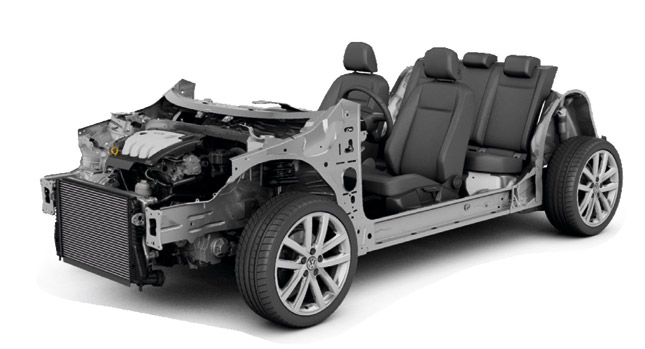At an event held today at its headquarters in Wolfsburg, Germany, Volkswagen revealed its new “Modularer Querbaukasten” or MQB platform that will form the base for the upcoming seventh generation Golf as well as a large number of other mainstream models.
The MQB is by far the most important platform architecture in the group, as it will be used in the next generations of the Volkswagen Polo, Beetle, Golf, Scirocco, Jetta, Tiguan, Touran, Sharan, Passat, and CC, as well as the soon-to-be revealed Audi A3, and all the other derivatives from Seat and Skoda.
 A key feature of the platform is its flexibility in terms of wheelbase length, track width, wheel size and seating positions. Other dimensions such as the distance between the pedals to the wheel center are always the same and provide a unified front-end system.
A key feature of the platform is its flexibility in terms of wheelbase length, track width, wheel size and seating positions. Other dimensions such as the distance between the pedals to the wheel center are always the same and provide a unified front-end system.
Volkswagen says that in spite of different wheelbases and track widths, all MQB models will be able to be built on the same production line, regardless of the brand. For example, in theory, the German group could assemble the next Seat Ibiza together with the next VW CC in the same factory.
Another highpoint of the flexible structure is the uniform (transversely mounted) installation position of all motors, be they gasoline, diesel or alternative propulsion systems such as hybrids and pure electric motors.
Volkswagen also revealed that it has developed two new engine lineups that are integrated in the MQB strategy: the modular petrol engine (MOB) with outputs ranging from 60 PS to 150PS, which will include the world’s first inline-four with cylinder deactivation (ACT), and the modular diesel engine (MDB) producing from 90PS to 190PS.
The German company says that the new engine series will reduce the Group’s engine and gearbox variants in the MQB system by around 90 per cent.
The new MQB-based Volkswagen Golf MK7 is expected to be introduced at the Paris Motor Show this fall, while its Audi A3 sibling will make its world premiere at the Geneva Motor Show in March.
PHOTO GALLERY









